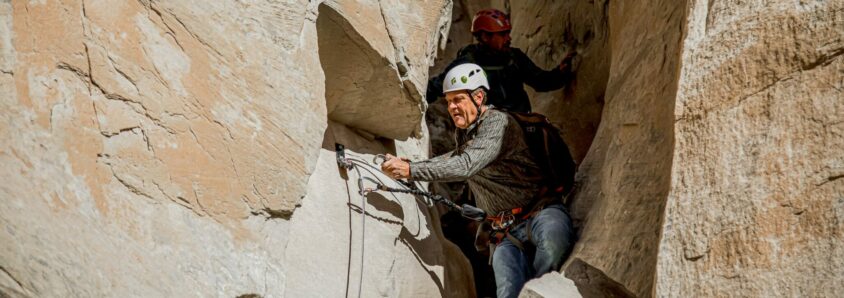Prime Insurance Company provides smart solutions for insurance producers and their clients as rock climbing professionals. With Prime, your clients get customized coverage all in one policy, including:
- Commercial general liability
- Professional liability
- Equipment coverage
- Alleged assault and battery liability
- Alleged sexual abuse and molestation liability
- TRU Umbrella
- And more!
Rock climbing is an exhilarating and adventurous sport that attracts thrill-seekers from all walks of life. As an insurance producer, you can help your rock climbing guide clients ensure the safety of their operations while they provide an unforgettable experience. In this blog post, we will discuss some essential risk management tips specifically tailored for rock climbing guides and instructors.
8 Risk Management Tips for Rock Climbing Guides
- Conduct Thorough Risk Assessments
Before embarking on any climbing expedition, it is essential to conduct a thorough risk assessment. Evaluate the difficulty level of the climb, the terrain, weather conditions, and any potential hazards. By identifying and addressing potential risks beforehand, you can take proactive measures to minimize accidents and injuries.
- Check and Maintain Equipment Regularly
Rock climbing equipment plays a vital role in ensuring the safety of climbers. Inspect and maintain all equipment regularly, including climbing ropes, carabiners, harnesses, helmets, and anchors. Follow the manufacturer’s guidelines and replace any worn-out or damaged equipment immediately.
- Ensure Proper Training and Certification
As a rock climbing guide, it is crucial to have comprehensive training and certification. Stay updated with the latest techniques, safety protocols, and emergency response procedures. Encourage your clients to undergo proper training and certification as well to ensure they have the necessary skills to participate in the activity safely.
- Develop Clear and Concise Communication Channels
Clear and effective communication is essential during a climbing expedition. Establish a system of communication that is easily understood by all members of the group. Use hand signals, verbal cues, and other communication tools to ensure everyone is on the same page and can respond quickly in case of emergencies.
- Create and Enforce Safety Guidelines
Establishing clear safety guidelines and ensuring their enforcement is critical for risk management. Communicate these guidelines to your clients before the climb and make sure they understand and follow them. Safety guidelines may include wearing appropriate protective gear, maintaining proper climbing techniques, and adhering to group dynamics while on the climb.
- Conduct Regular Training Exercises
Regular training exercises allow you to practice emergency response procedures and ensure that all team members are prepared for unexpected situations. Simulate scenarios such as equipment failure, injuries, or adverse weather conditions to test your team’s response capabilities. Training exercises help build team cohesion and reinforce proper risk management practices.
- Maintain Adequate Levels of Fitness
Rock climbing can be physically demanding, and guides must maintain a high level of fitness. Regular exercise and conditioning help enhance strength, endurance, and agility, reducing the risk of injuries during climbs. Encourage your clients to focus on their fitness levels before attempting challenging climbs.
- Have Liability Insurance
Liability insurance is an essential aspect of risk management for rock climbing guides. Accidents and injuries can happen despite all the necessary precautions. Having liability insurance provides protection against potential legal claims and financial liabilities that may arise from accidents or injuries during climbing expeditions.
When it comes to liability insurance for rock climbing guides, Prime Insurance Company is the best option. Prime Insurance Company is an excess and surplus (E&S) lines insurance company specializing in property and casualty insurance for specialty and unique risks. With over 40 years of experience, Prime Insurance Company understands the unique risks faced by rock climbing guides and offers rock climbing liability insurance tailored to their needs.
Prime Insurance Company treats every insured as a partner, taking a hands-on approach to finding unique solutions for every client’s insurance needs. Their in-house underwriting and risk management teams collaborate to write flexible and customized policies. By partnering with Prime Insurance Company, rock climbing guides can have peace of mind, knowing that they have a reliable insurance partner to protect them and their clients from potential liabilities.
Sharing Risk Management Tips with Your Rock Climbing Guide Clients
In conclusion, effective risk management is crucial for rock climbing guides to ensure the safety of their clients and the success of their climbing expeditions. By following these risk management tips, including conducting thorough risk assessments, maintaining equipment, proper training and certification, clear communication, enforcing safety guidelines, regular training exercises, maintaining fitness levels, and having liability insurance, rock climbing guides can mitigate potential risks and provide a safe and memorable climbing experience. Don’t forget to share these tips with your clients to promote safety awareness and encourage responsible climbing practices. Remember, Prime Insurance Company is here to support you and provide the best rock climbing liability insurance coverage in the industry.
Get a Rock Climbing Insurance Quote
Go to https://www.primeis.com/quotes/ to find out how you can get a quote or call 800-257-5590 to speak with an underwriter today!
Helpful Rock Climbing Resources:
Climbing Safety Tips – National Park Service
The American Alpine Club
American Safe Climbing Association


